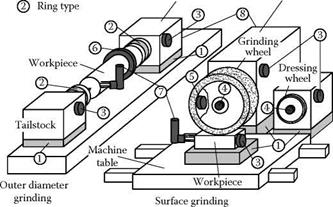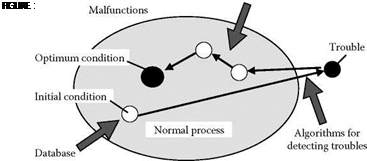As with all manufacturing processes, ideally, the variables of greatest interest are measured directly as close to their origin as possible. Grinding processes are affected by a large number of input variables that each influence the resulting output quantities. Brinksmeier [1991] proposed a systematic approach to distinguish between different types of quantities to describe a manufacturing process precisely [Marinescu et al. 2004].
The most common sensors to be used in either the industrial or the research environment are for force, power, and acoustic emission (AE) [Byrne et al. 1995]. Figure 11.2 shows the setup for the most popular integration of sensor systems in either surface or outer diameter grinding. Sensors mainly have to detect grinding performance during the period of intermittent contact between the grinding wheel and workpiece. Only during this limited interaction can many process quantities be detected.






 |
AE-sensors
© Easy mounting on
housings or workpiece
© Rotating in spindle center, wireless data exchange
© Eccentric rotating, slip ring/wireless data exchange
© Ring type rotating, wireless data exchange
© Fluid coupled power sensors
® Voltage or current
measurement of drive motors
 |
FIGURE 11.3 Grinding forces measurement with platform dynamometer.
